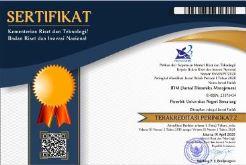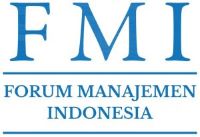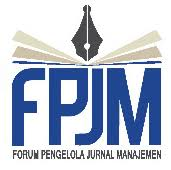Factors Affecting Customer Loyalty of Fitness Centers: An Empirical Study
Abstract
Awareness of healthy lifestyle in society is increasing day by day. Therefore, the fitness centers more motivated to focus on these business opportunities. Hence, it is important for companies to understand how to satisfy consumers to obtain consumer loyalty. Main variables were applied to predict customer loyalties areswitching cost, customer value, physical environment, and customer satisfaction. Data was collected through questionnaires distribution to students at private university in Tangerang. Data then was analyzed to by applying multipleregressionswith SPSS software. The results showed that there are three hypotheses are supported. The hypothesis is the relationship between switching cost and customer value, the relationship between customer value and customer satisfaction, and the relationship between customer satisfaction and customer loyalty. There is a hypothesis that is not supported, namely the relationship between the physical environment and customer satisfaction. This study also provides a discussion and offers direction for further research.
Kesadaran akan hidup sehat dalam masyarakat semakin meningkat. Oleh karenaitu, perusahaan-perusahaan pusat kebugaran termotivasi untuk focus pada peluang bisnis ini. Dengan demikian, pemahaman akan kepuasan konsumen yang dapat menjadikan konsumen semakin loyal adalah penting bagi perusahaan. Penelitian ini focus pada variable biaya perpindahan, nilai yang diterima konsumen, lingkungan fisik, dan kepuasan konsumen dalam memprediksi loyalitas konsumen. Data dikumpulkan melalui penyebaran kuesioner pada mahasiswa di sebuah universitas swasta. Data kemudian dianalisis dengan menggunakan regresi berganda. Hasil penelitian menunjukkan bahwa terdapat tiga hipotesis yang didukung. Hipotesis tersebut adalah hubungan antara biaya perpindahan dan nilai yang diterima konsumen, hubungan antara nilai yang diterima konsumen dan kepuasan konsumen, dan hubungan antara kepuasan konsumen dan loyalitas konsumen. Terdapat satu hipotesis yang tidak didukung, yaitu hubungan antara lingkungan fisik dan kepuasan konsumen. Penelitian ini menyampaikan pembahasan dan arah atas penelitian selanjutnya.
Keywords
Full Text:
PDFReferences
Akbar, M. M & Parvez, N. 2009. Can Service Quality, Trust, and Customer Satisfaction Engender Customer Loyalty?ABAC Journal. 29: 24-38.
Alshibly, H. H. 2014. A Free Simulation Experiment to Examine the Effects of Social Commerce Website Quality and Customer Psychological Empowerment on Customers’ Satisfaction.Journal of Business Studies Quarterly. 5(4): 21-40.
Anderson, R. E & Srinivasan, S. S. 2003. E-satisfaction and E-loyalty: A Contingency Framework. Psychology and Marketing. 20: 1-16.
Angelova, B & Zekiri, J. 2011.Measuring Customer Satisfaction with Service Quality Using American Customer Satisfaction Model (ACSI Model).International Journal of Academic Research in Business and Social Sciences.1: 232-258.
Anwar, S & Gulzar, A. 2011. Impact of Perceived Value on Word of Mouth Endorsement and Customer Satisfaction: Mediating Role of Repurchase Intentions. International Journal of Economics and Management Sciences. 1: 46-54.
Ariff, M., Fen, H. S & Ismail, K. 2012. Relationship Between Customer’ Perceived Values, Satisfaction and Loyalty of Mobile Phone Users.Review of Integrative Business and Economics Research. 1 (1): 126-135.
Auka, D. O. 2012. Service Quality, Satisfaction, Perceived Value and Loyalty among Customers in Commercial Banking in Nakuru Municipality,Kenya.African Journal of Marketing Management. 4 (5): 185-203.
Bester, P. 2012. The Business Environment of Sport Organizations: A Review. African Journal of Business Management, 6 (46), 11530-11535.
Bose, S & Rao,V. G. 2011. Perceived Benefits of CustomerLoyaltyPrograms: Validating the Scale in the Indian Context. Management and Marketing Challenges for the Knowledge Society. 6: 543-560.
Bradley, R. H. 1999. The Home Environment. In S. L. Friedman & T. D. Wachs (Eds.), MeasuringEnvironment Across Life Span: Emerging Methods and Concepts. Washington, DC: American Psychological Association. 31-58.
Brennan, R & Henneberg, S. C. 2008. Does PoliticalMarketingNeed the Concept of CustomerValue?Marketing Intellegence and Planning. 26(6): 559-572.
Burnham, T. A., Frels, J. K & Mahajan, V. 2003. Consumer Switching Cost: A Typology, Antecedents, And Consequences. Journal of the Academy of Marketing Science. 31(2): 109-126.
Churchill, G. A. 2004. Basic MarketingResearch, 5th ed. South-Western, Mason: OH.
Day, E. 2002. The Role of Value in ConsumerSatisfaction. Journal of Customer Satisfaction, Dissatisfaction and Complaining Behavior. 15: 22-32.
Deniz, K. 2006. Reliability and Validity of Turkish Version of Customer Satisfaction Scale for Health Care and Fitness Clubs. Unpublish Thesis. GraduateSchool of Social Science. Turkish: Middle East Technical University.
Fortuin, F. T. J. M & Omta, S. W. F. 2007. Aligning R&D to Business-A Longitudinal Study of Customer Value in R&D. International Journal of Innovation and Technology Management. 4(4): 393-413.
Hair, J. F., Anderson, R. E., Tatham, R. L & Black, W. C. 2006. Multivariate data analysis, New Jersey: Prentice-Hall International, Inc.
Hijjah, R & Ardiansari, A. 2015. Pengaruh Customer Experience dan Customer Value terhadap Customer Loyalty melalui Customer Satisfaction. Management Analysis Journal. 4(4): 281-288.
Hofmeyr, J & Rice, B. 2000. Commitment-Led Marketing.Chichester: John Wiley and Sons Ltd. 299.
Hossain, M., Islam, M. Z & Mohammad, H. 2012.Factors Affecting Customer Switching Resistance Amongthe Telecommunication Subscribers. Middle-East Journal of Scientific Research. 12: 815-825.
Jain, P & Kumar, A. 2015.Investigating the Moderating Role of Switching Cost in The Relationship of E-service Quality, Perceived Customer Value, Satisfaction and Loyalty towards Online TravelAgencies. International Journal in Management and Social Science, 3, 323-333.
Jamil,B & Aryaty, A. 2010.The Influence of Relationship Quality on Loyalty in Service Sector.International Journal of Economics and Management. 4(1): 81-100.
Jen, W., Lu, M., Hsieh, E. H., Wu, Y. H& Chan, S. M. 2013. Effects of Airport Servicescapeon Passengers’ Satisfaction: A Hierarchical Approach and Importance-Performance Analysis. Proceedings of the Eastern Asia Society for Transportation Studies. 9: 1-12.
Johan, M. R. M., Noor, N. A. Z. M., Bahar, N., Yan, L. M & Ping, L. H. 2014. Factors Affecting Customer Loyalty Towards Airlines Industry in Malaysia: An Exploratory Analysis. Interdisciplinary Journal of Contemporary Research in Business. 6: 12-23.
Jones, M. A., Mothersbaugh D. L & Beatty S. E. 2000. Switching Barriers and Repurchase Intention in Service. Journal of Retailing, 76: 259-274.
Kanten,S & Yaslioglu, M. 2012. Roleof Innovation in Creating Customer Value in Hotel Establishments: A Study of Managers. The Journal of Faculty of Economics and Administrative Sciences. 17: 437-449.
Khan, S. 2013. Attaining Customer Satisfaction! The Role of Customer Value and Relation Base Marketing a Study of Policy Holders of Peshawar Pakistan. International Journal of Managing Value and Supply Chain. 4: 11-24.
Kim, S. S., Lee, C. K. & Klenosky, D. B. 2003. The Influence Push and Pull Factors at Korean National Parks. Tourism Management. 24: 169-180.
Kotler, P. 2000. Marketing Management: The Millennium Edition. London: Prentice Hall International Inc.
Kotler, P & Armstrong, G. 2010. Principles of Marketing, 13th ed. Upper Sadle River, NJ: Pearson Education., Inc.
Kuusik, A. 2007. Affecting Customer Loyalty: Do Different Factors Have Various Influences in Different Loyalty Levels?Tartu University Press. 366: 1-29.
Lai, L. H., Liu, C.T & Lin, J.T. 2011. The Moderating Effects of Switching Costs and Inertia on the Customer Satisfaction-Retention Link: Auto Liability Service in Taiwan. Insurance Market and Companies: Analyses and Acturial Computations. 2: 69-78.
Lee, J., Lee, J & Feick, L. 2001. The Impact of Switching Costs on the Customer Satisfaction-Loyalty Link: Mobile Phone Service in France. Journal ofService Marketing.15: 35-48.
Levesque,T & McDougall, G. H. G. 1996. Determinants of Customer Satisfaction in Retail Banking.International Journal of Bank Marketing. 14: 12–20.
Mathuramaytha, C & Ussahawanitchakit, P. 2008. What is a Guide for Firms?: The Creation of CustomerValue. International Journal of Business Strategy. 8(2): 128-136.
Melewar, T. C., Karaosmanoglu, E & Paterson, D. 2005. Corporate identity: Concept, Components and Contribution.Journal of General Management, 31(1), 59-81.
Miles, P., Miles, G & Cannon, A. 2012.Linking ServiceScape to Customer Satisfaction: Exploring the Role of Competitive Strategy.International Journal of Operations and Production Management, 32, 772-795.
Milfelner, B. 2009. The Role of Proactive and Responsive Market Orientation in the Development ofa Firm’s Innovation resources.NaseGospodarstvo. 55: 51-58.
Mittal, V & Kamakura, W. A. 2001.Satisfaction, Repurchase Intent, and Repurchase Behavior: Investigating the Moderating Effect of Customer Characteristics. Journal of Marketing Research.38 (1).131-142.
Molina-Castillo, F., Rodriguez-Escudero, A & Munuera-Aleman, J. 2012. Do Switching Costs Really Provide a First-Mover Advantage? Marketing Intelligence & Planning. 30: 165-187.
Mols, N. P. 1998. The Behavioral Consequences of PC Banking. International Journal of Bank Marketing. 16: 195–201.
Morgan, R. M & Hunt, S. D. 1994. The Commitment Trust Theory of Relationship Marketing. Journal of Marketing. 58: 20-38.
Nakamura, A. 2010. Estimating Switching Costs Involved in Changing Mobile Phone Carriers in Japan: Evaluation of Lock-in Factors Related to Japan’s SIM Card Locks. Telecommunications Policy. 34: 736–746.
Nguyen, N., Leclere, A & LeBlanc, G. 2013. The Mediating Role of Customer Trust on Customer Loyalty. Journal of Service Science and Management. 6: 96-109.
Payne, A & Holt, S. 2001. Diagnosing Customer Value: Integrating the Value Process and Relationship Marketing.Bristish Journal of Management. 12: 159-182.
Rahman, M. A & Kamarulzaman, Y. 2012.The Influence of Relationship Quality and Switching Costs on Customer Loyalty in the Malaysian Hotel Industry.Social and Behavioral Sciences. 62: 1023-1027.
Ricki, A & Raharso, A. 2008. The Impact of Switching Costs on Customer Loyalty: A Study Among Customers of Mobile Telephony. Journal of Applied Finance and Accounting.1: 39-59.
Ryu, K & Han, H. 2010. Influence of Physical Environment on Disconfirmation, Customer Satisfaction, and Customer Loyalty for First-Time and RepeatCustomers in Upscale Restaurants. International CHRIE Conferenced-Refereed Track. 13: 1-8.
Salamat, N., Farahani, A&Salamat, F. 2013. Customer Satisfaction in Private and Public Fitness Clubs in North ofIran.African Journal of Business Management. 7(18): 1826-1832.
Schiffman, L. G & Lazar, K. 2004. Consumer Behavior.8th ed. Upper Saddle River, NJ: Prentice Hall.
Sharma, N. 2013. The Role Pure and Quasi-Moderators in Services: an Empirical Investigation of on Going Customer-Service-Provieder Relationship. Journal of Retailing and Consumer Services. 10(4): 253-262.
Sekaran, U & Bougie, R. 2010. Research Methods for Business: A Skill Building Approach. 4th ed. New York: John Wiley & Sons.
Shankar, V., Amy, K., Smith, A. K&Rangaswamy, A. 2003.Customer satisfaction and loyalty in online and offline environments.International Journal of Research in Marketing. 20: 153-175.
Spiteri, J. M & Dion, P. A. 2004. Customer Value, Overall Satisfaction, end-User Loyalty, and Market Performance in Detail Intensive Industries. Industrial Marketing Management. 33(8): 675-687.
Sugiati, T., Thoyib, A., Hadiwidjoyo, D & Setiawan, M. 2013.The Role of Customer Value on Satisfaction and Loyalty (Study on Hypermart’sCustomers). International Journal of Business and Management Invention. 2: 65-70.
Sumadi & Soliha, E. 2015. The Effect of Brand Image and TRust on Loyalty Mediated by Customer Satisfaction. Jurnal Dinamika Manajemen, 6(2): 121-32.
Tsai, M. T., Tsai, C. L & Chang, H. C. 2010. The Effect of Customer Value, Customer Satisfaction, and Switching Costs on Customer Loyalty: An Empirical Study ofHypermarkets in Taiwan. Social Behavior and Personality. 38 (6): 729-740.
Wood, K & Van Herdeen, C. H. 2007. The Relationship between E-service Quality, E-value, E-satisfaction and E-loyaltyin Online Tourism Portals.South African Journal of Economic and Management Sciences. 10(3): 281-297.
Yang, Z & Peterson, R. T. 2004. Customer Perceived Value, Satisfaction, and Loyalty: The Role of Switching Cost. Psychology and Marketing. 21 (10): 799-822.
View Counter: Abstract - 4540 and PDF - 2648
Refbacks
- There are currently no refbacks.





